While Manila mulls over filing a case against China with so-called "solid evidence of the damaged coral reefs caused by Chinese actions," China, on Monday, released a report based on an unprecedentedly extensive and detailed on-site ecosystem survey around Ren'ai Jiao (also known as Ren'ai Reef), with solid evidence showing that the grounded warship has caused damage to the coral reefs and environmental pollution in the South China Sea.
Based on remote-sensing and field investigation, the survey showed a sharp decline in the distribution of scleractinia coral on the reef flat and lagoon slope of Ren'ai Jiao, particularly around the area where the Philippines' military vessel is illegally grounded.
High concentrations of heavy metals, dissolved inorganic phosphorus, and oils were also found in the area, along with anthropogenic disposals such as fishing nets, according to the survey report.
Experts who participated in the field survey told the Global Times that solid evidence and scientific analysis showed that the vessel's grounding process, heavy metal precipitation caused by the ship's corrosion, and the discharge of garbage and sewage from the personnel on the vessel have had a long-term hazardous impact on the health of corals.
As the Philippines intensified its cognitive warfare against China, the report revealed the truth clearly that it is the Philippines' grounded military vessel at Ren'ai Jiao that is causing significant harm to the marine environment, they stressed.
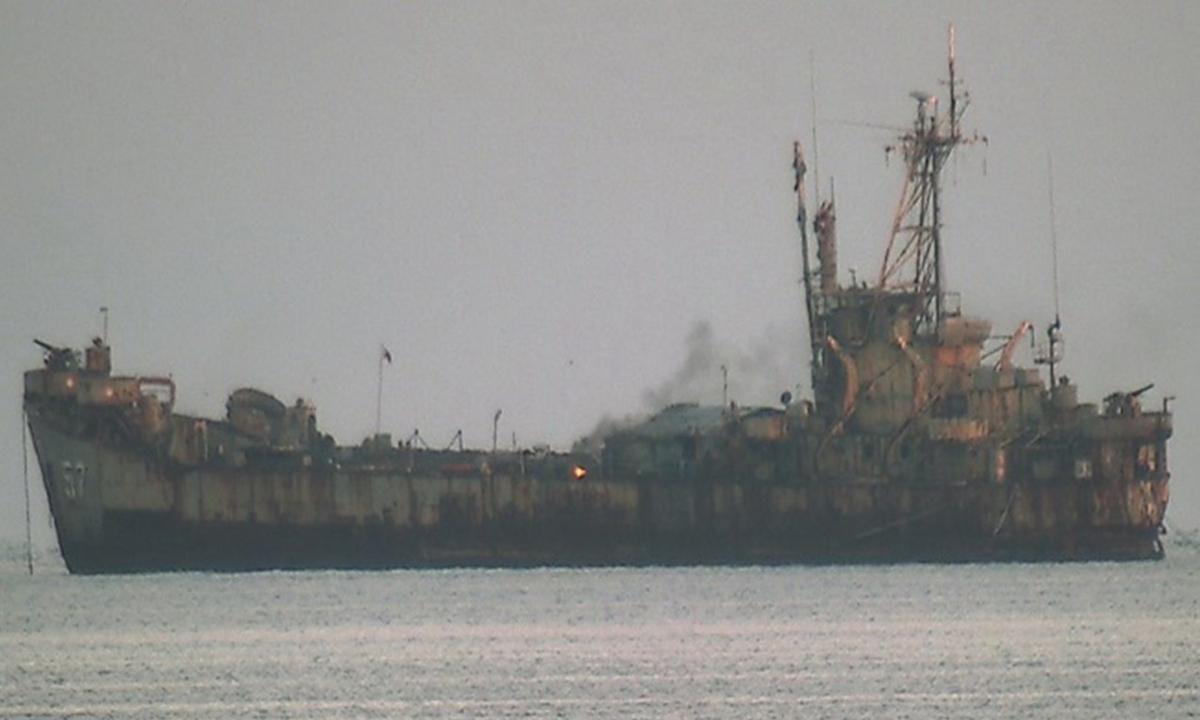
Philippine personnel burn garbage on the deck of the illegally "grounded" military vessel in 2014. Photo: Courtesy of South China Sea Ecological Center of China's Ministry of Natural Resources
What Chinese researchers have foundFrom April 21 to 26, the South China Sea Ecological Center and the South China Sea Development Research Institute from China's Ministry of Natural Resources conducted an extensive ecosystem survey that was carried out in 18 stations at Ren'ai Jiao, with over 70 parameters grouped into corals, reef dwellings, environmental factors, and human activities.
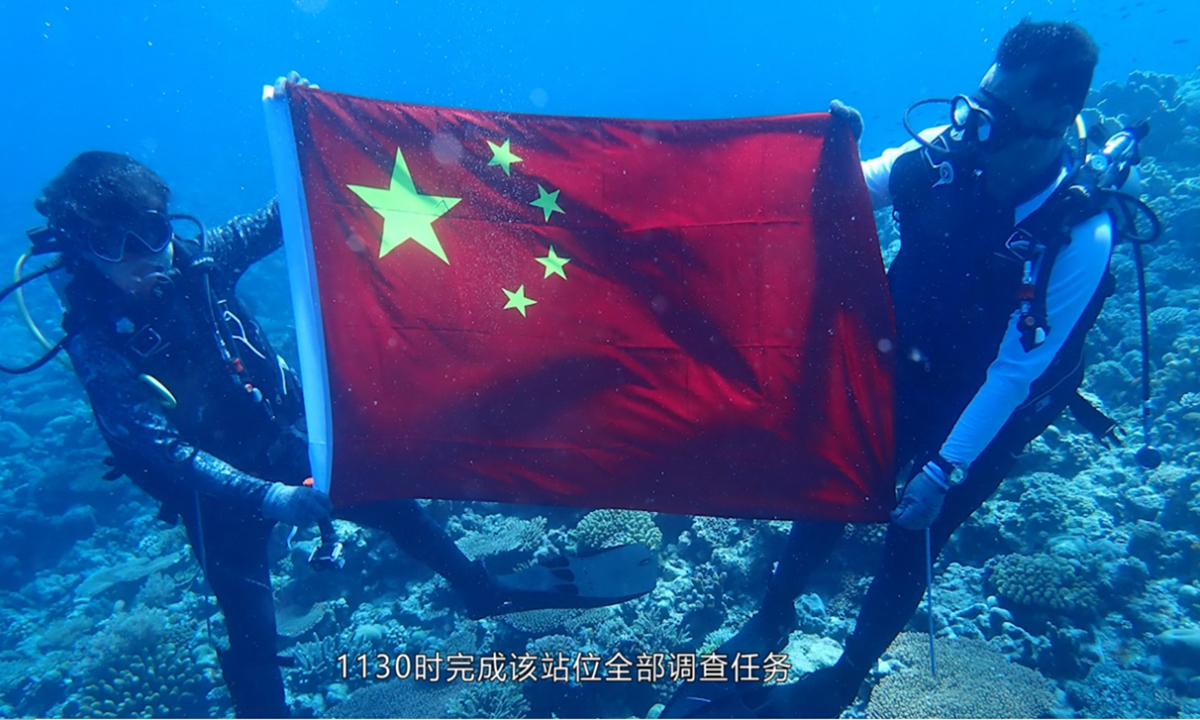
The Chinese research team concludes its field investigation at Ren'ai Jiao, on April 26, 2024. Photo: Courtesy of South China Sea Ecological Center of China's Ministry of Natural Resources
Based on the remote sensing inversion of high-resolution satellite images, the Chinese research team discovered that scleractinia live coral cover had decreased dramatically at the reef flat and lagoon slope of Ren'ai Jiao, especially in the adjacent area of the illegally grounded military vessel.
The scleractinia coral distribution area had decreased by 38.2 percent compared with 2011. In particular, the scleractinia coral distribution area has decreased by 87.3 percent in the adjacent area of the illegally grounded military vessel within a 400-meter radius.
In addition, the scientists found that massive fragments of dead scleractinia coral were scattered in the groove of the seaward slope in the west-northwest of the illegally grounded military vessel with a nearly 500-meter distance. A lot of dead corals were found 300 meters northwest of the vessel by an unmanned aircraft.
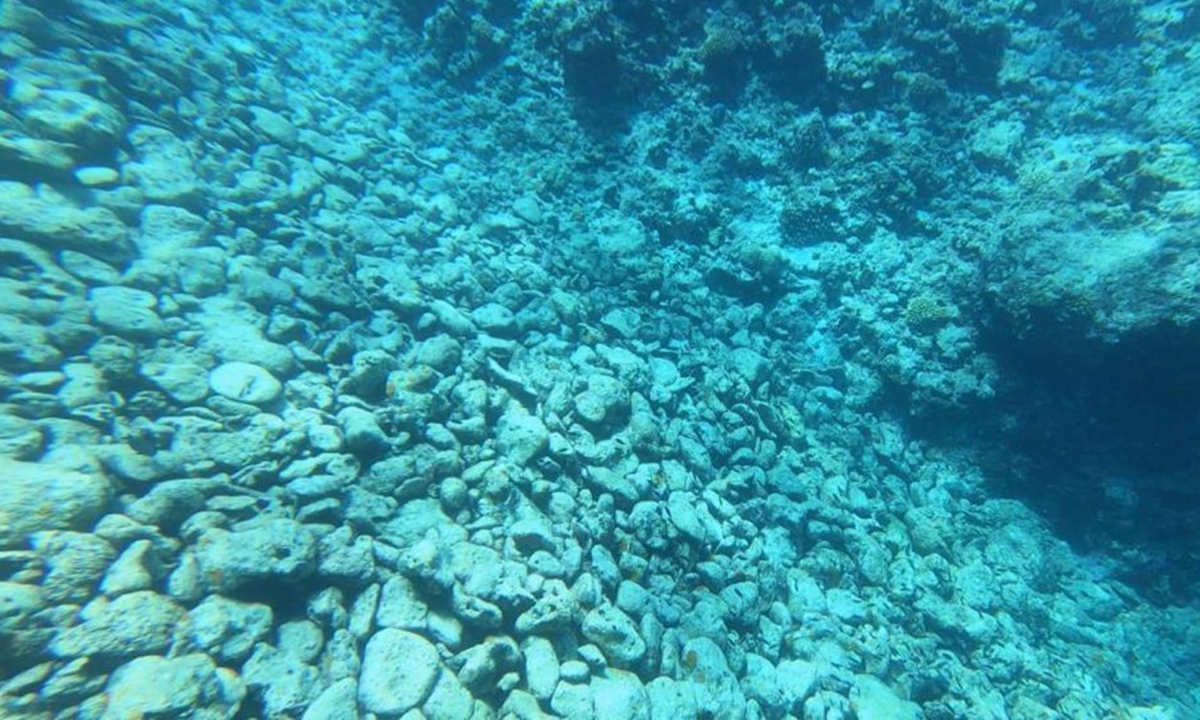
Photo taken by scientists who dived in the water near Ren'ai Jiao shows large amounts of coral fragments in the groove. Photo: Courtesy of South China Sea Ecological Center of China's Ministry of Natural Resources
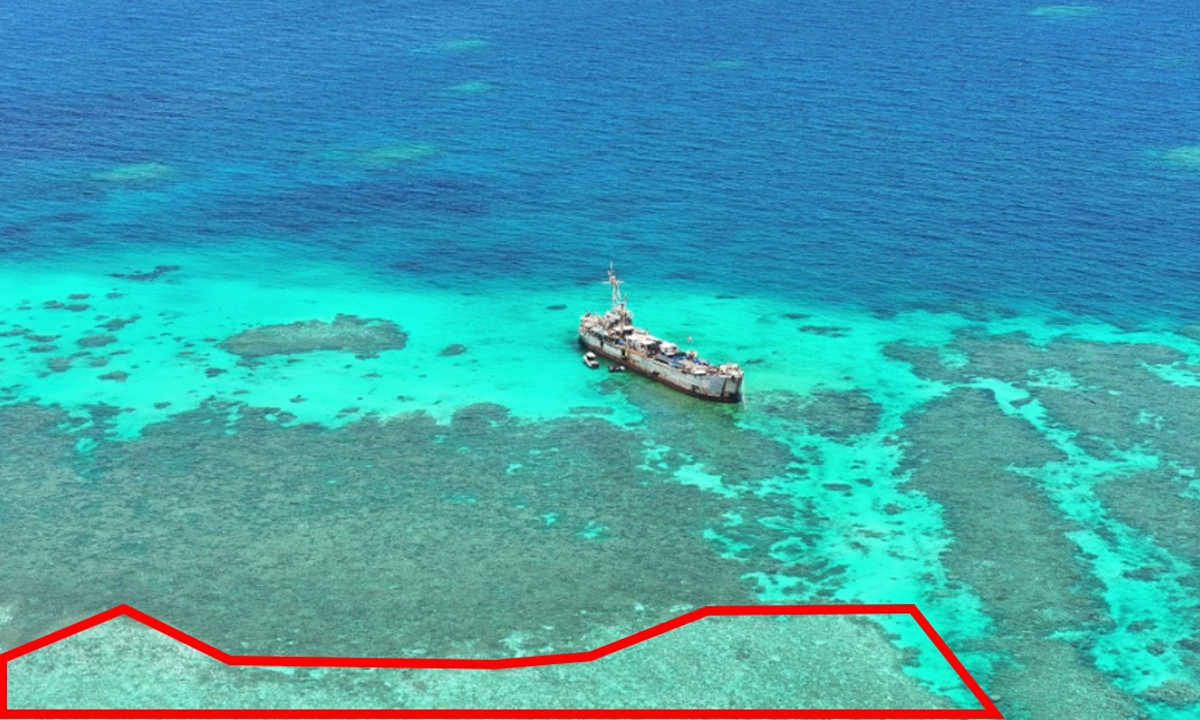
Photo taken by unmanned aircraft shows a great deal of dead corals found in the red polygon. Photo: Courtesy of South China Sea Ecological Center of China's Ministry of Natural Resources
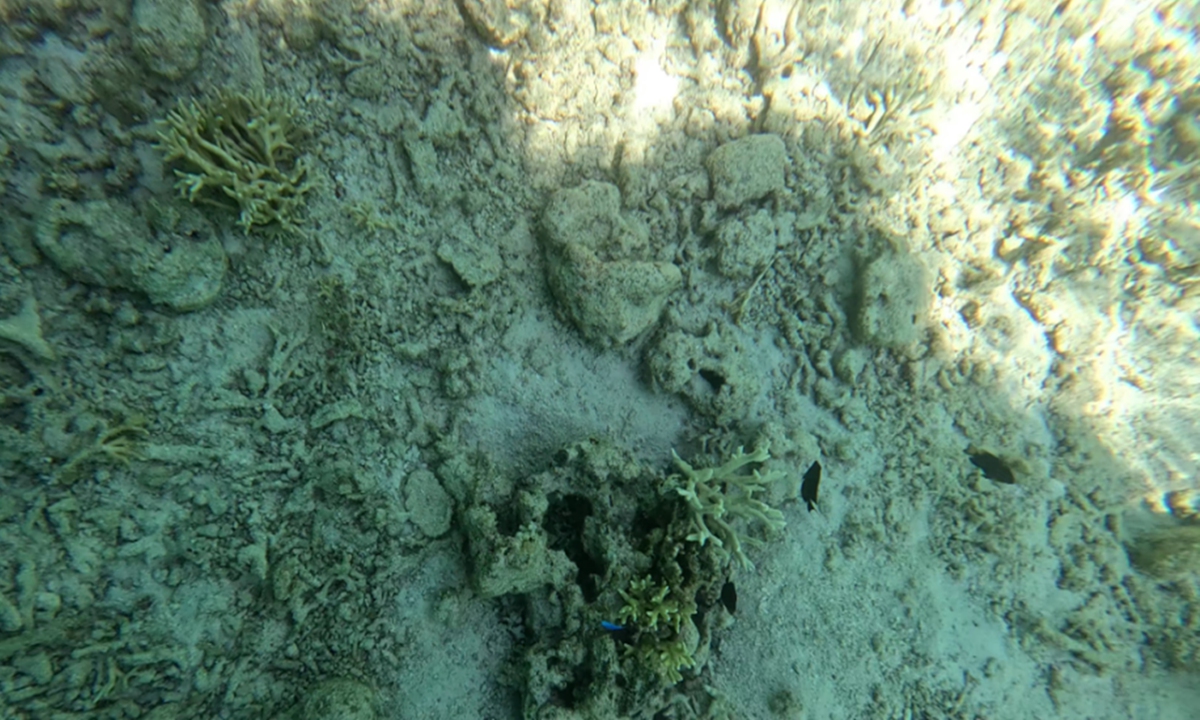
Photo taken by scientists who dived in the water near Ren'ai Jiao shows dead corals scattered in the reef flat. Photo: Courtesy of South China Sea Ecological Center of China's Ministry of Natural Resources
Apart from dead coral and coral fragments, the researchers also found that benthic invertebrates at Ren'ai Jiao were rare, especially in the area around the illegally grounded military vessel.
Economic species such as crustaceans, bivalvia, and gastropods that are commonly distributed in coral reef ecosystem, were rarely detected in all 13 ecological stations that the Chinese research team deployed. Crustaceans were found only in a station that was farther away from the illegally grounded military vessel. The densities of the above-mentioned economic species at stations closer to the illegally grounded military vessel, were lower than the other stations at Ren'ai Jiao.
Furthermore, samples surveyed found that the concentrations of heavy metals, dissolved inorganic phosphorus, and oils were significantly higher than historical records. Mercury, copper, zinc and dissolved inorganic phosphorus were detected in surface seawater collected at all 18 stations, and oils were detected in nine stations, with average concentrations that were remarkably higher than historical records before the vessel's illegal grounding.
Massive discarded anthropogenic disposals including fishing nets were easily found at Ren'ai Jiao, according to researchers.
Anthropogenic disposals including fishing nets and threads, special fishing devices and ropes, rubber loops, scrap iron, glass, plastic bottles, and wooden sticks were observed from the surface or seabed in all of the 13 ecological stations. Some of the disposed items have Philippine marks.
During the field survey, plenty of Philippine fishing boats were found in the lagoon of Ren'ai Jiao conducting constant activities.
In particular, a large abandoned fishing net, with a height of 5 meters and length of 300 meters, was found on the east side of the illegally grounded military vessel, which should be responsible for the mass dead scleractinia corals. Part of the fishing net was hanging in the seawater, and part of it entangled and covered the corals. The scene in the pictures is reminiscent of a young child's face being smothered by a tattered cloth, struggling to breathe.
Two buoys were detected on the surface of the water on the north side of the illegally grounded military vessel. They were secured to the seabed by ropes and iron, where the scleractinia corals were found to be completely dead. In addition, the coral reef, where the east side buoy was secured, was found completely destroyed.
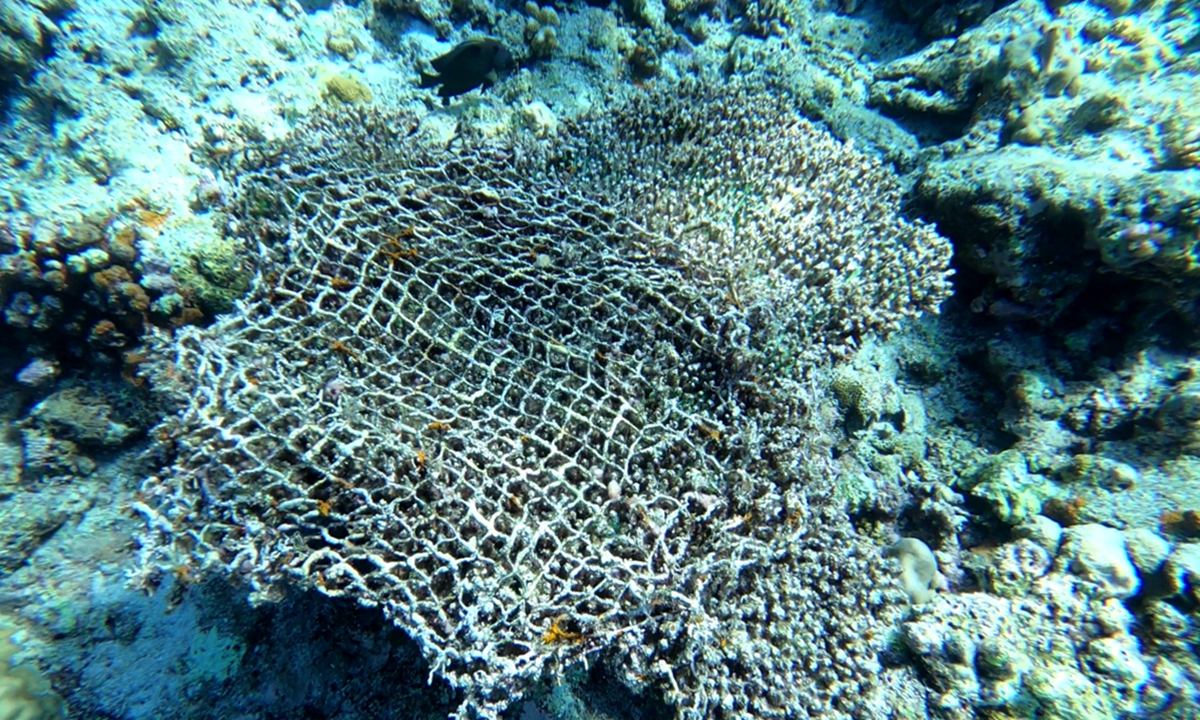
Photo taken by scientists who dived in the water near Ren'ai Jiao shows fishing nets and threads on the seabed. Photo: Courtesy of South China Sea Ecological Center of China's Ministry of Natural Resources
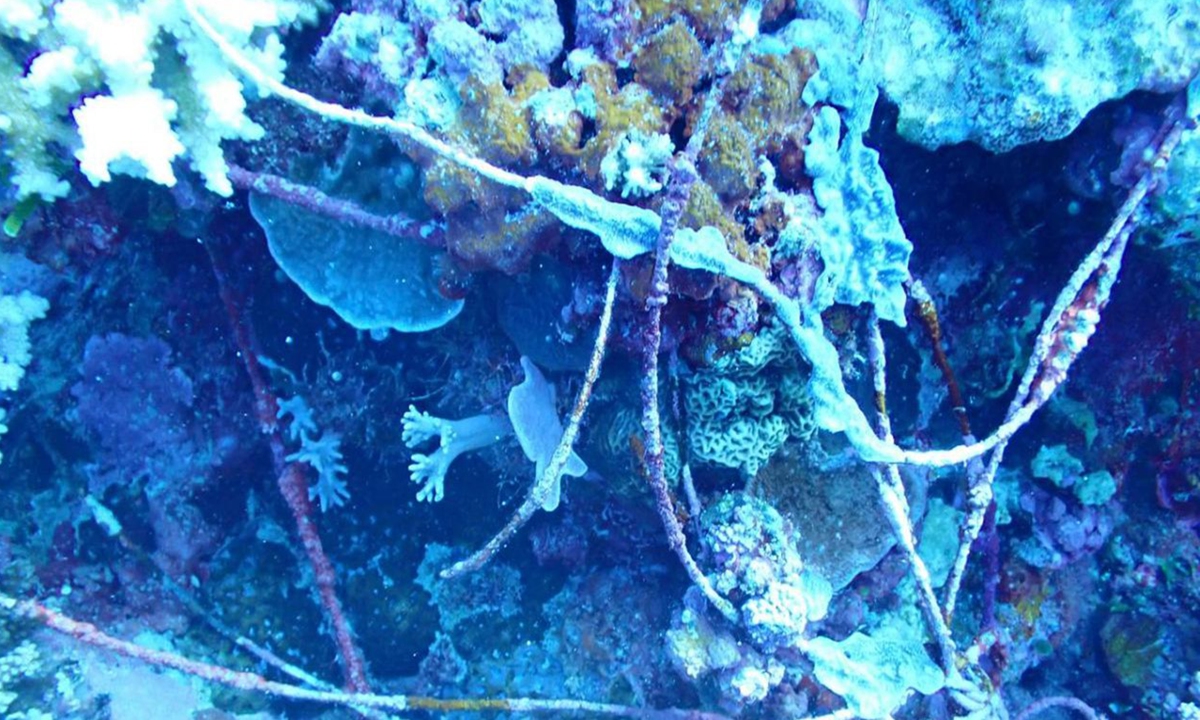
Photo taken by scientists who dived in the water near Ren'ai Jiao shows fishing nets and threads on the seabed. Photo: Courtesy of South China Sea Ecological Center of China's Ministry of Natural Resources
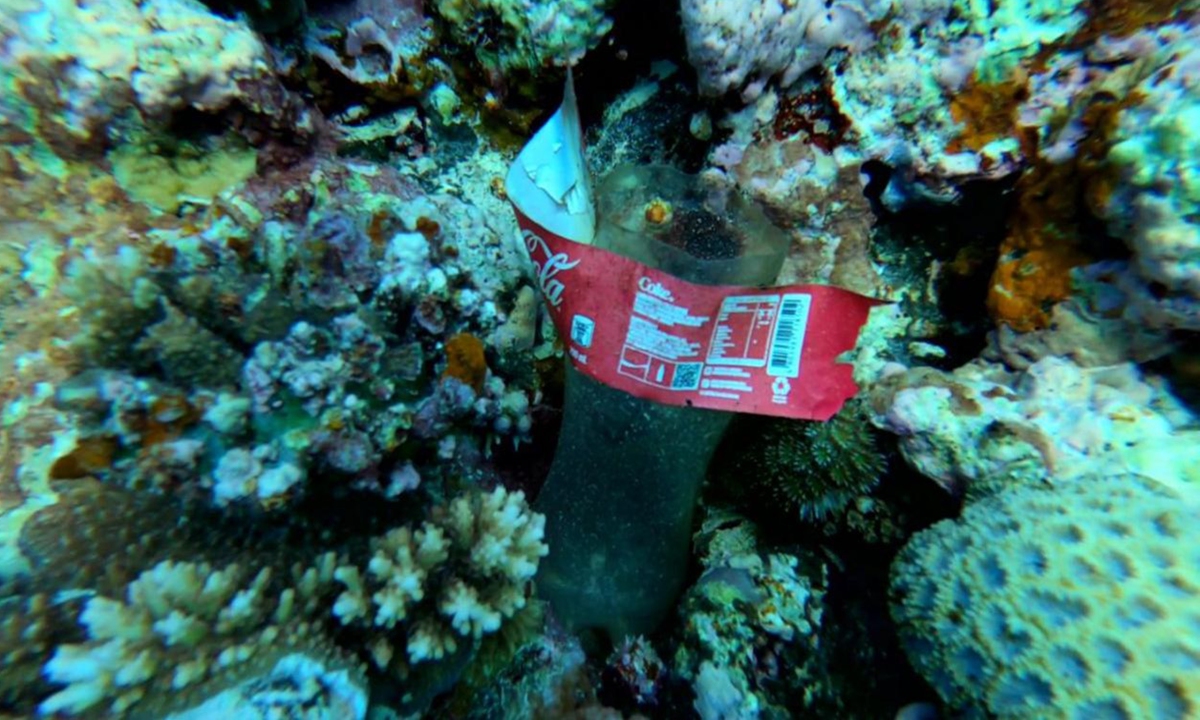
Photo taken by scientists who dived in the water near Ren'ai Jiao shows a piece of anthropogenic disposal (a barcode starting with "480,"represents the Philippines as the production location). Photo: Courtesy of South China Sea Ecological Center of China's Ministry of Natural Resources
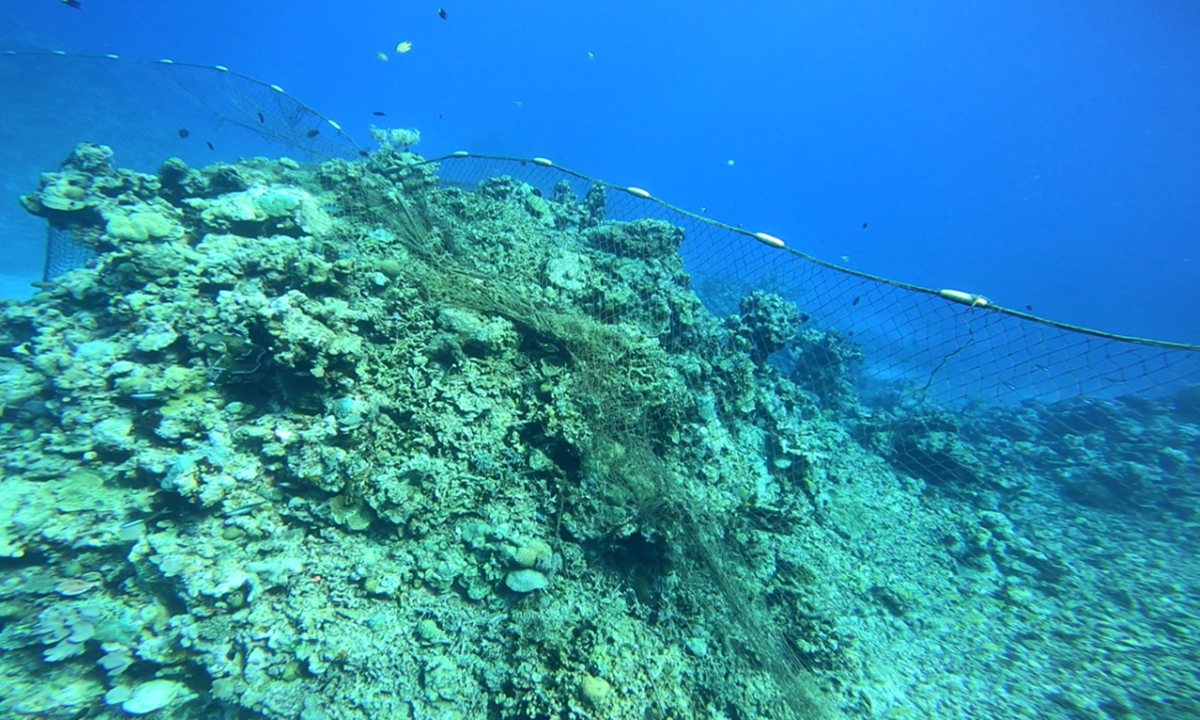
Photo taken by scientists who dived in the water near Ren'ai Jiao shows the fishing net on the east side of the illegally "grounded" military vessel. Photo: Courtesy of South China Sea Ecological Center of China's Ministry of Natural Resources
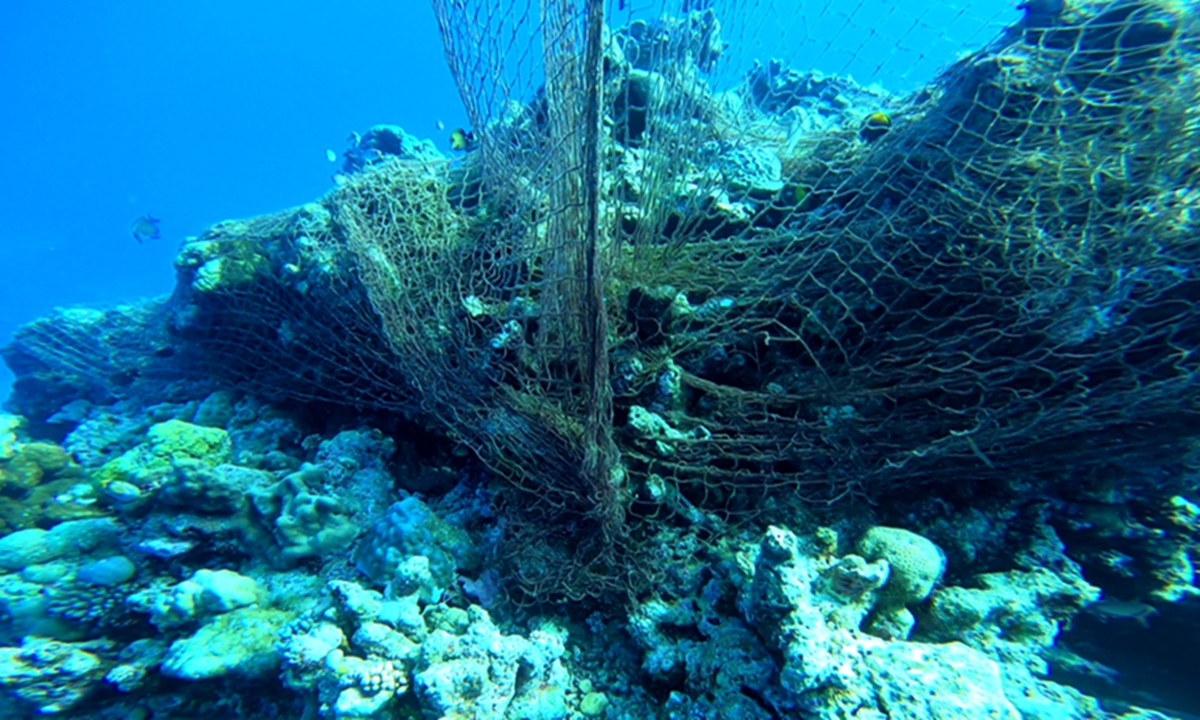
Photo taken by scientists who dived in the water near Ren'ai Jiao shows the fishing net on the east side of the illegally "grounded" military vessel. Photo: Courtesy of South China Sea Ecological Center of China's Ministry of Natural Resources
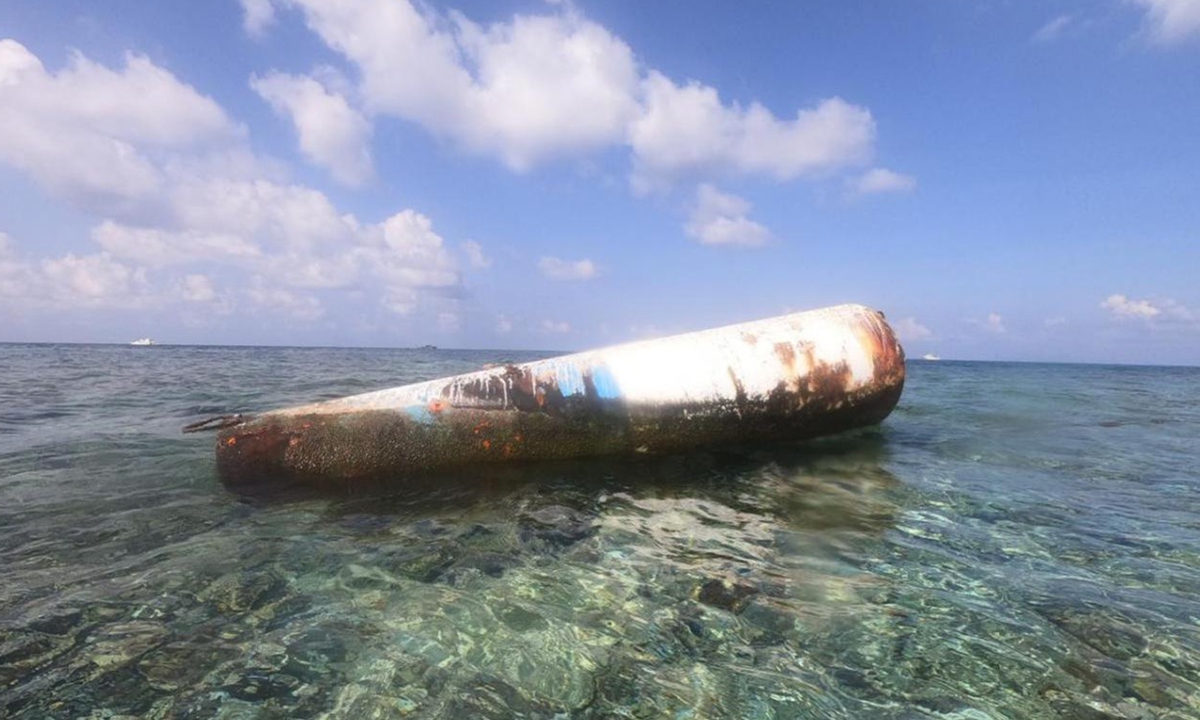
Photos taken by scientists show buoys and the dead corals underneath on the north side of the illegally "grounded" military vessel. Photo: Courtesy of South China Sea Ecological Center of China's Ministry of Natural Resources
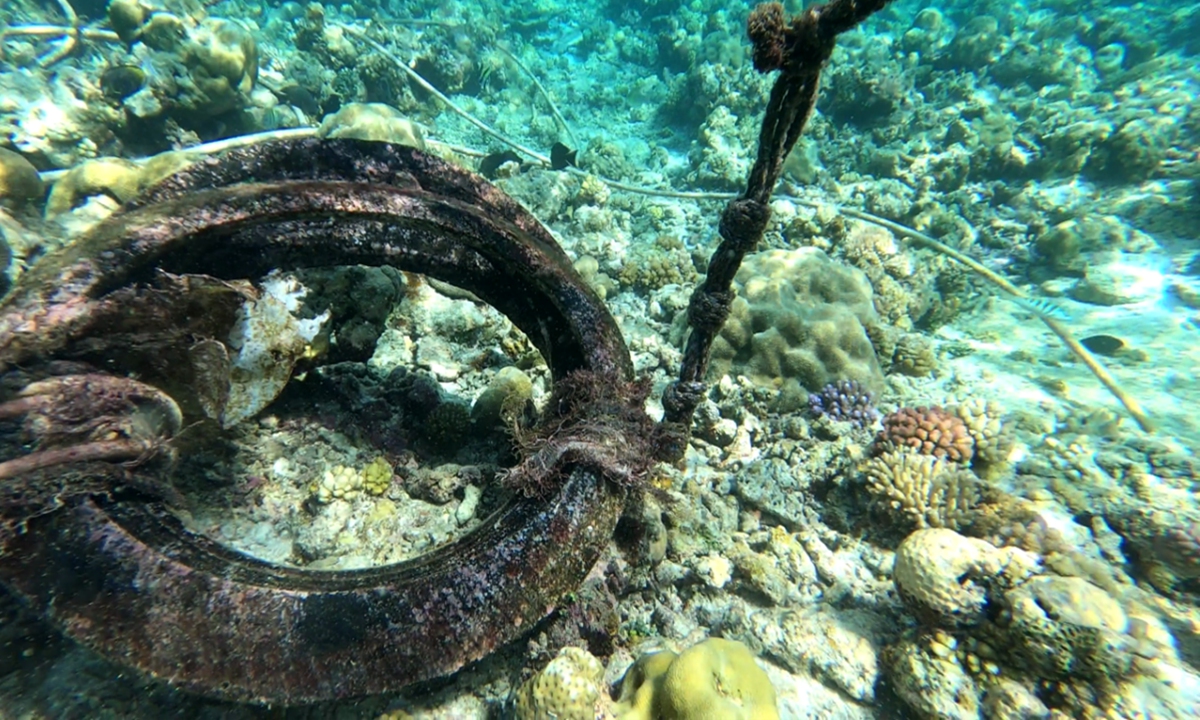
Photos taken by scientists show buoys and the dead corals underneath on the north side of the illegally "grounded" military vessel. Photo: Courtesy of South China Sea Ecological Center of China's Ministry of Natural Resources
How coral reefs were damagedYou may be wondering why researchers could be certain that these damages were not caused by natural factors.
Through a thorough examination of historical data, it was discovered that there were no records of natural accidents including devastating typhoons, oil spills, or shipwrecks around Ren'ai Jiao since the military vessel was illegally grounded here.
Furthermore, field surveys did not uncover any evidence of large-scale coral bleaching or outbreaks of coral predators.
By ruling out these potential natural causes, Chinese researchers are confident that the damage and degradation of the coral reef ecosystem at Ren'ai Jiao can be attributed primarily to the grounded military vessel and related human activities.
Xiong Xiaofei, a senior engineer at the South China Sea Ecological Center, Ministry of Natural Resources, who participated in the field survey, told the Global Times that the grounding process of the vessel caused fatal damage to the coral reef and benthic invertebrates within the trajectory zone by crashing, cutting, and rubbing against the reef flat. In addition, a large number of coral reef fragments piled up around the hull of the ship, and these fragments would cover or even bury the corals and benthic invertebrates nearby due to the effects of currents and waves.
Heavy metal precipitation caused by the grounded vessel corrosion and destruction, as well as the discharge of garbage and sewage from the Philippines, are long-term hazards to the health of corals.
Previous images and videos the Global Times obtained from the China Coast Guard show that the hull of the grounded vessel is worn out and leaking, with a significant amount of paint peeling off and corroded rust water flowing into the sea. A Filipino military personnel on the vessel was suspected of urinating into the waters of Ren'ai Jiao, a picture shows. Earlier videos this year also revealed how they dump wastewater and burn garbage on the foredeck of the vessel.
Xiong said that concentrations of heavy metals, oils, and inorganic phosphate increased significantly compared with their historical records before the military vessel was illegally grounded in May 1999. It is elucidated that the serious corrosion and destruction of the hull, as well as discharge of waste oil and sewage, the incineration and disposal of garbage from Philippine personnel on the illegally grounded military vessel, and the surrounding fishing boats were the key reasons.
Fishing waste discarded by the Philippines from the illegally grounded military vessel and surrounding fishing boats such as fishing nets, threads, and discarded ropes were entangled on the surface of corals, which not only caused the corals to break and die, but also hampered coral ingestion. These factors have all caused a remarkable decline in economic organisms such as crustaceans, bivalvia, and gastropods in the reef area, and seriously threaten the health of the Ren'ai Jiao ecosystem, said the expert.
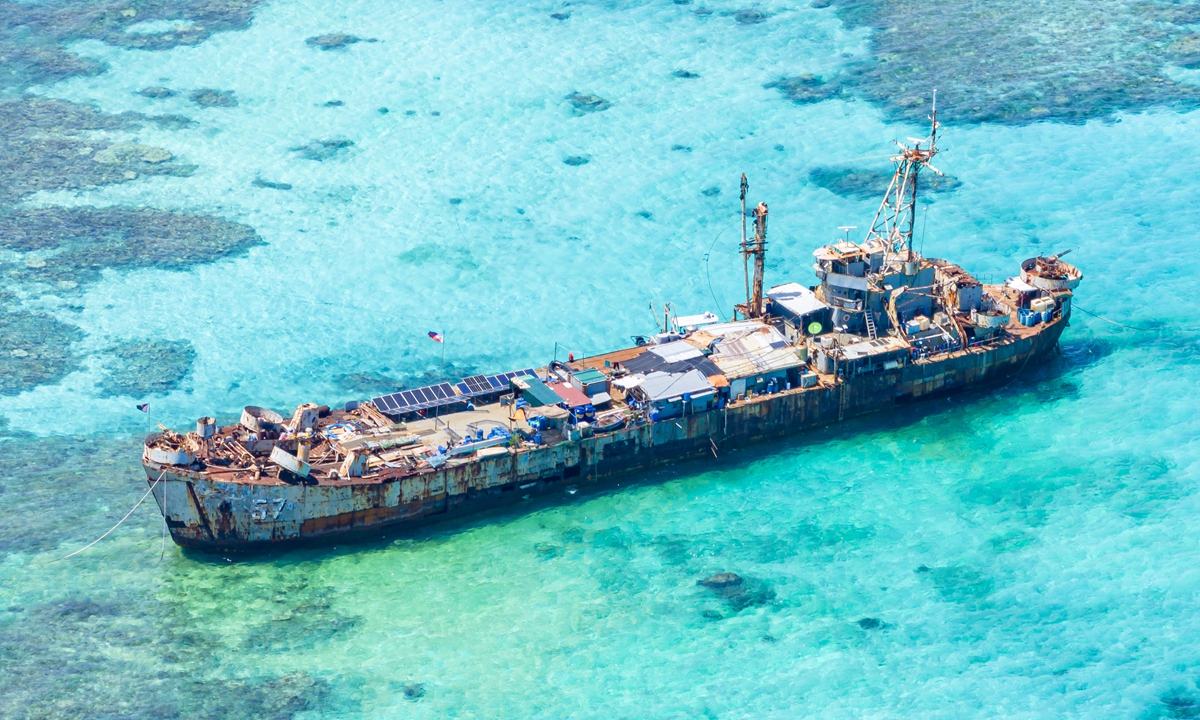
The Philippine illegally grounded warship BRP Sierra Madre at Ren'ai Jiao Photo: Courtesy of South China Sea Ecological Center of China's Ministry of Natural Resources
Who the real culprit isXiong told the Global Times that the coral reef ecosystem is the most important and typical ecosystem in the South China Sea, so the Chinese scientific research team pays special attention to its protection. Ren'ai Jiao is located in the Nansha Islands, and the Nansha Islands are located in the global "Coral Triangle," which contains the world's largest and richest area of coral reefs. The area's coral species and biodiversity are representative on a global scale.
"We were very saddened and remorseful to see a large number of coral fragments and dead corals at the investigation site. This shocking scene was also unprecedented for us," Xiong recalled.
Chen Xiangmiao, director of the World Navy Research Center at the National Institute for South China Sea Studies, told the Global Times that the Nansha Islands, including Ren'ai Jiao, are China's inherent territory. Conducting ecological surveys in this area is a legitimate way for China to assert its sovereignty and jurisdiction.
The survey findings, backed by authoritative evidence, revealed that a Philippine vessel engaged in unauthorized fishing, discharged wastewater and dumped garbage without proper precautions, leading to significant damage to the coral reef ecosystem in the region.
Chen emphasized that the 2016 invalid ruling on the South China Sea arbitration case, which accused China of harming coral reefs, and recent claims by some Philippine and Western media outlets about China causing ecological harm in the South China Sea, are totally baseless and ridiculous. The report clearly shows that the Philippines is the true culprit responsible for the deteriorative ecological environment in the South China Sea.
"The South China Sea, with its breathtaking beauty, has been a cherished homeland for Chinese fishermen for generations. It also serves as a vital ecological and environmental barrier for the coastal countries in the region. Therefore, it is imperative that we prioritize the protection of its delicate ecosystem, just as we value our own eyes," Yang Xiao, deputy director of the Institute of Maritime Strategy Studies, China Institute of Contemporary International Relations, told the Global Times.
The expert called for immediate action to mitigate the ongoing damage caused by the illegally grounded warship and demanded compensation from the Philippines for polluting Chinese territory.
















